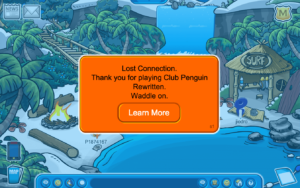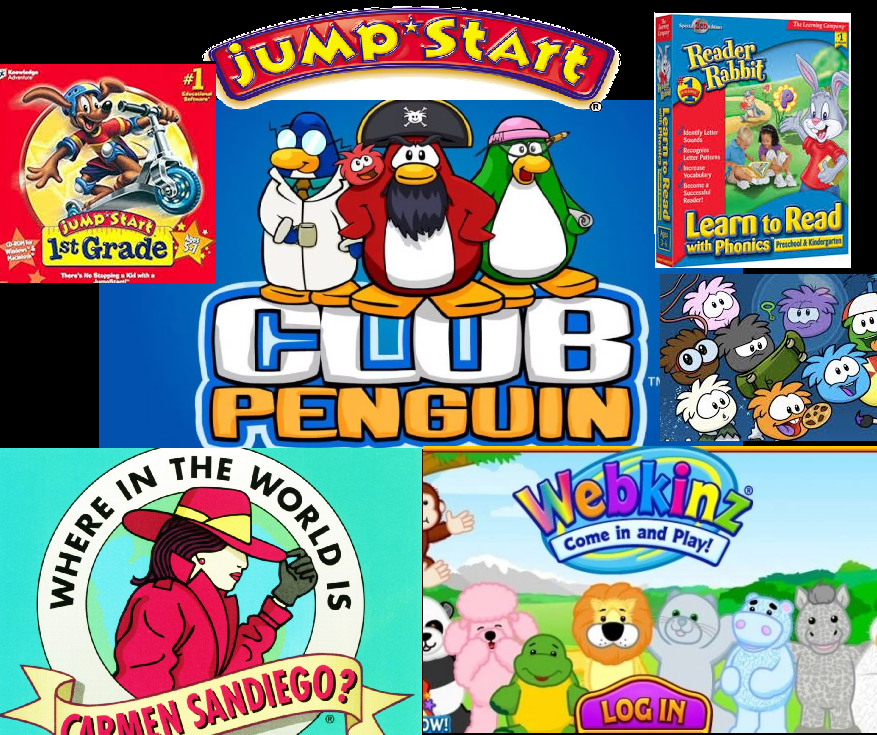Edutainment originally meant educational software for kids. Creators sought to make education fun and take advantage of new technology children already enjoyed using.
In the 1990s and early 2000s, edutainment software was huge. Reader Rabbit, Jump Start, Carmen Sandiego, Oregon Trail – to name a few – were massive franchises of learning software for home computers. Then the internet came along and you got things like Club Penguin and WebKinz – not exactly or entirely about education, but definitely with an educational vibe and component for kids.

Then………. POOF. They disappeared. Companies got bought up and merged. Software stopped coming out. Club Penguin was bought by Disney and then shuttered in 2017.
(Club Penguin does appear to have a “fan made server”: Club Penguin Legacy. I have no idea what the legal status of that site is. Visit at your own risk!)
Sales of educational software for home computers:
2000: $498 million
2004: $152 million
Yikes. What happened?
The Learning Company
One of the biggest players in the early edutainment market was The Learning Company. One of its co-founders, Warren Robinett, made the legendary game, Adventure, for Atari. Another, Teri Perl, is a titan in the history of mathemetics education for women and minorities. Carmen Sandiego, Oregon Trail, and Reader Rabbit were some of TLC’s biggest franchises. By the mid 1990s, TLC was booming: reaching $53 million revenue by 1995.
Meanwhile, Kevin O’Leary, today known as “Mr. Wonderful” from Shark Tank, and his office productivity software company SoftKey was floundering. Just take a moment to think about the prospects of SoftKey if it had continued to make office productivity software. Can you even think of a company other than Microsoft that succeeded in that market during that time period? What happened to WordPerfect? Lotus Notes? Have you even heard of those companies/products? They were huge at one point. Then Microsoft used its monopoly power to destroy them with Word and Excel.
O’leary was doomed and he knew it. So he started buying up edutatinment companies.
Turns out Mr. Wonderful ain’t so wonderful.
In 1995, O’Leary’s SoftKey edged out Broderbund to acquire TLC for $650 million and renamed itself TLC to benefit from TLC’s vastly superior reputation. It was sketchy from the start:
“A 1996 report from a forensic accounting firm – featuring a grab bag of red flags, including suspicious firing of auditors and overstated earnings – concerned TLC so much that the board insisted the purchase be made using cash, rather than stock.”
By 1998, TLC/SoftKey bought more than 20 companies, becoming the world’s second largest consumer software company after Microsoft.
“O’Leary basically saw software companies as commodities,” said Warren Buckleitner, editor of Children’s Technology Review. “He was the soulless businessperson who just came in and bought a bunch of companies and scaled them back and laid off all the good people.”
Then O’Leary sold TLC to Mattel for $3.5 billion.
The deal was ill-advised from the start. Analysts warned Mattel’s CEO, Jill Barad, that TLC was a “house of cards.” The business was boosting its revenue by purchasing new companies, but the significant acquisition costs weren’t reflected in their top-line earnings. Plus, O’Leary’s refusal to invest in research and development was finally catching up to him – after years with no significant updates, old standbys were beginning to run thin. There were even allegations (never tested in court) that TLC was shipping out inventory to stores who had secretly agreed not to return unsold merchandise, boosting the appearance of sales.
18 months later, Mattel sold TLC for $27 million.
“[TLC] killed the educational software industry. It killed it because there was so much product out there and all of the product was crap.” Bernard Stolar, former Mattel president
O’Learly scattered talent to the winds. He gutted and discredited the entire industry. Then he walked away will billions for himself and declared himself a genius.
What About Now?
When you google edutainment or educational software, they don’t even talk about educational software for kids. It’s all training and education for adults, vocations, job skills, etc. Those are definitely booming areas of software development, but its like the original meaning of the word has been forgotten.
In place of all those fun educational software franchises all you really have now for kids is Roblox and Minecraft. While admittedly not all those games’ revenue is from kids, you can see what a massive potential market they represent:
2024 Revenue:
Roblox: $3.6 billion
Minecraft: $220 million
Who is to say how much a robust, kids edutainment softwary indsutry could peel away from that nearly $4 billion in annual revenue from just 2 games.
Imagine games like Roblox whose first priority was learning, not making money.
With all the computer advancements of the last 20 years plus more ubiquitous and reliable broadband, imagine what an untapped market actual “edutaintment” for kids represents?
Until someone gives it a shot, we may never know.
Sources:
“How One Corporate Raider Destroyed the Educational Software Market” https://rangerrik.com/2018/09/26/how-one-corporate-raider-destroyed-the-educational-software-market/
“Shark Tank’s “Mr. Wonderful” helped kill the educational computer games industry” https://www.avclub.com/shark-tanks-mr-wonderful-helped-kill-the-educational-1829339516
“The rise and fall of the company behind ‘Reader Rabbit’ and all your favorite educational games. Inside the collapse of a once-robust industry, and the ‘Shark Tank’ star who abetted the process.” https://theoutline.com/post/6293/reader-rabbit-history-the-learning-company-zoombinis-carmen-sandiego



